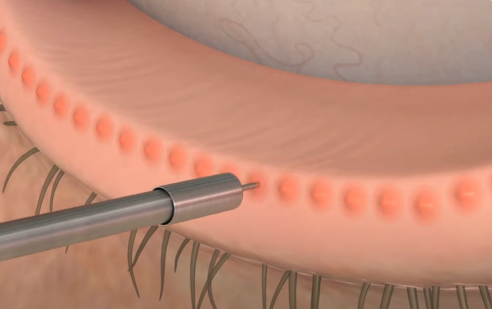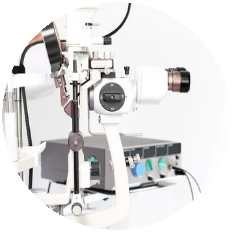Meibomian Gland Probing
What Is Meibomian Gland Probing?
Meibomian gland probing is a method of clearing internally blocked meibomian glands which are causing dry eye. Clearing the blockage allows them to return to secreting oils. A very fine wire, called a probe, is inserted into the glands to manually unblock them.

How Does Meibomian Gland Probing Work?
A full examination of the lid margins and glands is undertaken. This allows the consultant to see the exact status of the glands in terms of blockage and atrophy.
Next a special contact lens is placed in the eye over the cornea and a local anaesthetic is applied to the conjunctival sac and lower lid margin. The patient then closes their eyes for 10-15 minutes, after which they open their eyes and another drop of anaesthetic solution is applied to the conjunctival sac. There is some mild burning when the anaesthetic is first applied, but it wears off within 30 seconds.
A 1mm probe is then used to open the gland up. Once the gland is open, a 2mm or 4mm probe (depending on the length of the gland) is inserted.
Why Should I Have Meibomian Gland Probing?
Probing is of particular benefit for non-responsive meibomian gland disease, as it can partially restore gland patency and allow the gland to continue to secrete oil.
Does Meibomian Gland Probing Have Any Risks Or Side-Effects?
If the right protocols are followed, meibomian gland probing is a safe procedure.
Who Will Carry Out My Treatment?
Your procedure will be carried out by Mr Mark Yodaiken, a consultant ophthalmologist with considerable expertise in gland probing.
Will I See A Result From Meibomian Gland Probing Immediately?
Meibomian gland probing usually gives relief from discomfort within a few days if it is successful. However, re-growth of the glands is more gradual.
Can Anyone Have Meibomian Gland Probing?
Although opticians and optometrists can also administer LipiFlow, at our clinic you can choose to have it done by a consultant ophthalmologist. Discounts are available for LipiFlow treatments carried out by a nurse or optometrist. However, your initial assessment will always be with a consultant ophthalmologist.
The probe is gently pushed through the gland, clearing any obstruction. Probing relieves fixed obstructions such as fibrosis. Resistance usually indicates fibrotic tissue blocking the gland and requires slightly more force to be used. Successful release of these fibroses causes a popping sound and the probe then passes freely through the gland.
Once the glands have been cleared, the eye is cleaned thoroughly with saline to remove any leftover anaesthetic. For the next few hours, you may need eye drops to help wash away any debris that comes out of the newly opened glands.
Can Anyone Have Meibomian Gland Probing?
Anyone can have meibomian gland probing. Those who benefit most are those who have internal blockages. The procedure is both diagnostic and therapeutic, in that it excludes the presence of blockages or clears blockages which are present.
How Long Does The Improvement In Symptoms Last?
Many patients only need a single probing treatment. Others might need repeat probing, either for glands which couldn’t be unblocked the first time, or if glands become re-obstructed. With successful initial probing, repeat probing is not usually needed for at least seven months, and often more.
What Are The Success Rates Of Meibomian Gland Probing?
Almost all of Mr Yodaiken’s patients show some degree of improvement.
It is important to remember that patients who have probing often have very advanced disease with significant gland loss. Probing can help to slow further gland loss and, in some cases, some glands can recover a small amount. Due to the disease being so advanced, probing patients have a symptomatic improvement but don’t have a complete recovery.
Although probing is often reserved for moderate to severe disease, Mr Yodaiken’s view is that it can also be beneficial for those with mild disease to prevent progression. This can be discussed in detail at your consultation.







